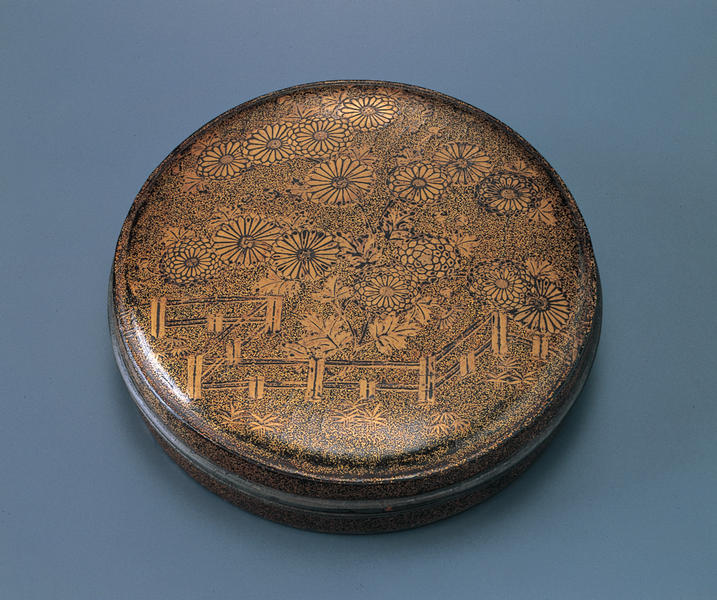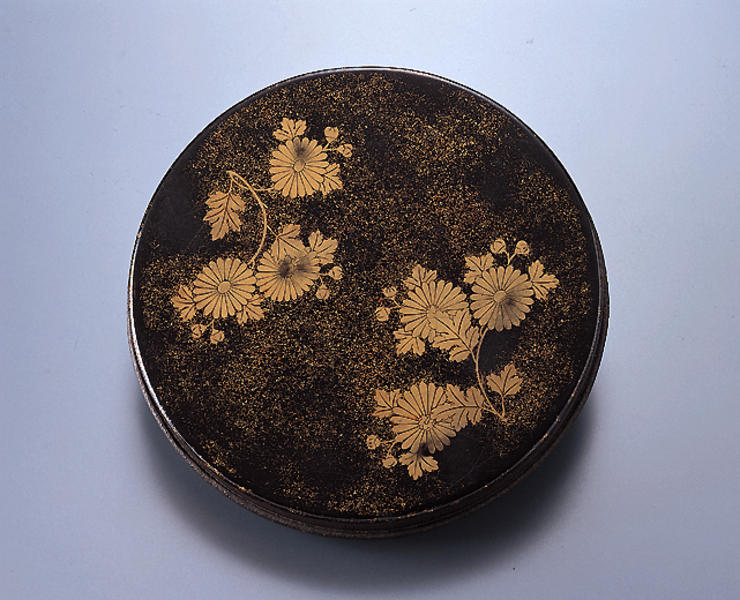籬菊蒔絵香合(鏡箱)
- 南北朝~室町時代
- 14~15世紀
- 黒漆塗に濃梨地、錫縁、金高蒔絵、研出蒔絵、切金
- H-3.7 D-13
- 所蔵
- MIHO MUSEUM
室町時代 15世紀
高:3.7cm 径:12.8cm
円形,甲盛り,錫縁の鏡箱。総体黒漆塗に濃梨地。蓋表には籬に菊の株を配す。菊花には単弁と複弁の花が,また,表から描いた花,裏から描いた花,蕾,葉と描き分けられる。技法は金高蒔絵。蓋裏は菊の折枝を三つ研出蒔絵で表し,見込みは宝珠・鍵・宝袋・丁字・小槌など宝尽文唐織裂(江戸時代)が貼られている。さらに,底部にまで菊の折枝が研出蒔絵で装飾されている。
籬に菊蒔絵というと,鎌倉時代の国宝籬菊蒔絵硯箱(鶴岡八幡宮所蔵)が連想される。また,この硯箱と一具であり,明治6年(1873),ウィーン万国博覧会に出陳され,翌年帰路,伊豆沖で積載船の沈没で失われた同意匠の手箱が思い起こされる。この鏡箱もこれらの菊意匠蒔絵の手箱の内容品であったことは明らかに推測される。
箱書は蓋表に墨書で「時代鏡栖 香合」とある。鏡栖は鏡巣・鏡箱の意で,香合は後世茶の湯の世界で香合に供せられたという意である。蓋裏に表とは別筆で「鎌倉時代 籬に菊蒔絵鏡箱 一合 寸法径一三・七センチ 松田権六識之」とある。松田権六(1896~1986)は漆芸家,人間国宝,文化勲章受章者。(灰野)
蒔絵
蒔絵
日本の漆工芸を代表する加飾法で我が国独自に発展した。漆で文様を描き、乾かないうちに金銀などの金属粉を蒔きつけて文様を表す。起源は奈良時代に遡り、正倉院の金銀でん荘唐大刀の鞘に施された末金るの技法と考えられる。
塩屋千鳥蒔絵硯箱
浄土図蒔絵小箱
梅月文螺鈿蒔絵文台
雲錦蒔絵提重 伝 春正作
袋物蒔絵大鼓胴
藤蒔絵長持
秋草蒔絵沈箱
菊鶴亀蒔絵硯箱
蒔絵手拭掛
蒔絵角盥
亀甲文蒔絵香合(鏡箱)
桐蒔絵硯箱
枝垂桜蒔絵徳利
菊桐紋蒔絵盥
葡萄蒔絵水筒
桐巴紋枝垂桜蒔絵大棗
籬秋草桔梗紋散蒔絵厨子棚
雷雲蒔絵螺鈿鼓胴
Catalogue Entry
Muromachi period, 15th century
Height, 3.7cm; diameter, 12.8cm
Circular, with a rounded lid and copper edge. Coated overall with black lacquer. Thick nashiji ground. The exterior of the lid has a pattern of chrysanthemum bushes placed behind a low fence. The chrysanthemum blossoms have either a single or multiple rows of petals, and both the blossoms and leaves are depicted from above and from below. Gold takamakie technique. The interior of the lid has three branches of chrysanthemums created in togidashi makie, and the interior of the body of the box is lined with a karaori "Chinese-weave" fabric (Edo period) decorated with a pattern of jewels, keys, jewel pouches, clove, and small wands. The bottom of the body is also decorated with a togidashi makie pattern of chrysanthemum branches.
This fenced chrysanthemum makie pattern is reminiscent of the Kamakura period National Treasure Inkstone Box with Fenced Chrysanthemum Makie Decoration (Tsurugaoka Hachiman Shrine, Kamakura). There was also a tebako toiletries box that formed a set with the Tsurugaoka Inkstone Box, but it was lost at sea when the ship carrying the box back from its display at the 1873 Vienna World Exposition sank off the coast of the Izu Peninsula in 1874. The present mirror case can clearly be suggested as an interior fitting for a toiletry box with such a fenced chrysanthemum makie pattern.
The box inscription for this mirror case is inscribed on the exterior of the box lid in black ink. It reads "Antique Mirror Box Incense Container," indicating that this mirror case was used by later generations of tea masters as an incense container for the tea ceremony. The interior of the box lid states, in a different hand from the inscription on the exterior, "Kamakura period, mirror case with fenced chrysanthemum makie, measurements: diameter 13.7 centimeters, Matsuda Gonroku's opinion on this object." Matsuda Gonroku (1896-1986) was a lacquer artist designated a "Living National Treasure" and was a recipient of the Order of Cultural Merit. AH


